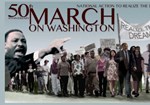Click here to read AFT President Randi Weingarten’s Address to the Crowd at March on Washington
They began arriving on the National Mall at dawn, coming from a dozen states—north, south, east and west—including more than 1,000 members from New York, hundreds from Maryland, and activists from as far as Florida, Illinois, Ohio, Oklahoma, Minnesota and Washington. By 8 a.m. on Aug. 24, AFT members were spilling onto the mall, joining thousands of fellow members and marchers carrying banners and signs for the 50th anniversary of the March on Washington for Jobs and Freedom.
As the crowd swelled to tens of thousands, a series of luminaries warmed them up, from New York’s United Federation of Teachers president Michael Mulgrew (“Who are the people? We are the people!”); to NAACP president Ben Jealous; to U.S. Attorney General Eric Holder, who paid tribute to civil rights leaders and spoke of their unfinished work. Fifty years after the march and 150 years after emancipation, he said, “justice is within our grasp.”
The AFT contingent helped highlight the union’s theme of “reclaiming the promise of public education.” During the day, volunteers handed out Reclaiming the Promise fans and information cards, and marchers who stopped by an AFT tent signed up to support ongoing efforts throughout the country to translate that theme into action.
U.S. Rep. John Lewis, the only surviving speaker from the 1963 march, urged Americans not to rest until Congress revitalizes the Voting Rights Act, saying he does not intend to stand by and let the Supreme Court take away the vote. “Stand up and make some noise!” he exhorted. “Hang in there. Keep the faith. I got arrested 40 times, but I’m not tired. I’m not weary. I’m ready to continue the fight.”
Then AFT president Randi Weingarten addressed the crowd, joined by Asean Johnson, a 9-year-old student activist from Chicago’s public schools. (See video at right.)
The little guy went first. At the 1963 march, Asean said, “Congressman John Lewis was the youngest speaker, and now, 50 years later, I am the youngest speaker. I am marching for education, justice and freedom.”
Weingarten noted that the AFT supported the original march and was doing so again. Looking out at the crowd, she observed “the beautiful diversity of our movement—all races, sexes, gay and straight and everything in between, civil rights activists, labor union members, DREAMers and communities of faith.”
She asserted that this march must not be merely a commemoration but “a continuation of that righteous fight to achieve real justice and opportunity for all.” The leaders of the 1963 march, she said, had understood the intersection of racial equality and economic justice, that the struggle for civil rights is also a struggle for good jobs that pay decent wages. They understood that a great nation makes sure every neighborhood public school is a good school. “They got it—that educational opportunity is the highway to economic opportunity,” she said.
Weingarten called for nonviolent protests in school districts that fail to fund public education. She called for a national day of prayer to end child poverty. She called for freedom rides on behalf of immigrant and gay rights. And she urged sit-ins to oppose “stand your ground” laws.

She was not alone. Myrlie Evers-Williams, former chair of the NAACP and widow of slain civil rights leader Medgar Evers, told the multitudes bearing pictures of Trayvon Martin, the unarmed Florida teenager shot to death last year, to “take the words ‘stand your ground’ in a positive sense. Take a negative and make a positive of it. Stand your ground for freedom and justice.”
Most of the day’s speakers celebrated Bayard Rustin as architect of the march. Without him, it would not have happened. Rustin remained behind the scenes as a gay black man in 1963 but planned every detail, from remembering trash bags to drafting a list of demands. Even before the march, Rustin shared a close friendship with Albert Shanker, then president of the United Federation of Teachers, who would go on to become president of the AFT. Rustin and Shanker worked together on the march and on later battles for equality, amplifying the voices of millions of African-Americans.
From his place in the audience on the steps of the Lincoln Memorial, AFT secretary-treasurer emeritus Nat LaCour said he was happy to attend the anniversary march because he hadn’t been at the first one, and voiced concern about the movement’s “unfinished agenda,” citing education, immigration, LGBT rights and women’s rights. “I’m particularly concerned about voter suppression and jobs—the loss of good-paying jobs,” he said. “The economy is still a big issue.”
LaCour hoped the march would send out a “clarion call” for voters to kick obstructionists out of office who oppose healthcare insurance and decent wages—except for themselves: “We’re not going to make the progress we need to make as long as we have these conservatives in Congress,” he said.
Two high school paraprofessionals from Baltimore agreed with that assessment and were eager to credit the AFT’s current secretary-treasurer, Lorretta Johnson, for their own activism in the Baltimore Teachers Union.

“If she thinks something should change, she makes it happen,” said Winston Talbott, a paraprofessional at Baltimore Polytechnic Institute. “It’s hard to find someone who’s so constant and dedicated, who is as highly respected by the people she’s negotiating with as the people she’s representing.”
Both Talbott and Rose McRae, a paraprofessional at Western High School, said they feel a responsibility to keep advocating for civil rights and to help revive a sense of urgency among young people who may not realize there’s still work to be done. “At this point, failure is not an option,” McRae said.
Johnnie and Beverly Robinson came to the march on a bus sponsored by the Chicago Teachers Union. The retired educators said they are concerned that some people want “to turn back the clock,” particularly efforts to limit the right to vote. “A march like this lets the other side know that we’re not asleep and that we see what they’re trying do,” said Johnnie Robinson.
For Beverly Robinson, the growing number of school closings in Chicago and other cities is a major issue. She has a message for those leading that effort. “We have to let those who want to close schools in mostly low-income and minority neighborhoods know that they will have a fight on their hands.”
Paula Bean got up at 4:30 in the morning for her hourlong bus ride from Baltimore to Washington. The teacher brought along her son, 31, and her 12-year-old grandson. “I wanted them to understand,” she said, “that the things they have, the things they take for granted, somebody had to pay a high price for those luxuries.”
Bean added that the day’s events had given her a chance to reflect and a chance to have a little fun, too, in the crisp air under brilliant sunshine. “It’s been an awesome experience,” she said, “just meeting people from everywhere.”
The AFT continues to mark the 1963 march by participating in events through Aug. 28, its actual anniversary.
[Annette Licitra, Roger Glass/video by Matthew Jones and Brett Sherman]


